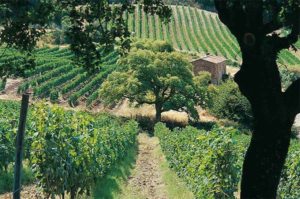Why “Super” Super Tuscans are like “Super” Yams
(Gerry Furth-Sides) Bold Italian Super Tuscans are like yams. Why? Because they both were named by savvy marketeers. And how grand. They are both extraordinary additions to the food and wine world.
The Super Tuscan story is not atypically Italian, with layers and layers that involved centuries of vintners, international marketing and the Italian government. On the simpler side: all yams in the United States are sweet potatoes, but to distinguish the finer quality, deeper colored and finer textures ones, a smart distributor names them “yams,” Red Garnet Yams to specifically denote the ones deeper red-orange color.

Engaging, entertaining and informative,Gold Pin professional sommelier Diego Meraviglia. This was the first seminar, where I ran to buy a bottle.
Engaging, entertaining and informative,Gold Pin professional sommelier Diego Meraviglia told the story. Most likely most wine lovers know it, even the most elementary. But he told it in such an informative way I ran to buy a bottle immediately after the seminar.
True: Marketers coined the term Super Tuscan in the early 1980’s with a need to describe a special red blend from Tuscany, unique because it may include the use of non-indigenous grapes, particularly Chianti, Merlot, Cabernet Sauvignon and Syrah. True: Tuscan in origin, but international in spirit, “Super Tuscans“ have represented some of the best bottlings to leave Italian soil, world-bound.
Diego Meraviglia shed new light and clarity on what many consider an often incorrectly described Italian wine category. He first laid the groundwork in history by extolling the praise of the heavenly, fertileTuscan region, where they can grow anything.” And, he emphasized, “in the 1400’s and the 1500’s when they were more like their own country, Tuscans were rebels; they were innovators. And Sienna was a fierce competitor with equally blessed Firenze. “They shared the same terroir with Sienna, super rich in limestone with the climate containing the perfect coolness of the mountains and the warmth of the Mediterranean, so the product was of the highest quality.
This was also Etruscan territory. The Etruscans were great farmers, great farmers. But they were terrible fighters, laughed Meraviglia. Note: The Etruscans were also excellent hydraulic engineers, who were so sophisticated they initially reclaimed part of marshy plains near the sea, and used it for agriculture. Rome, on the other hand, possessed excellent fighting skills. So they did a deal. The Etruscans traded their culinary secrets in return for Roman protection. This was to the extent that Rome is often credited with being the first to make great wine.
In an effort to deal with a slow bureaucracy in changing the wine law of Italy during the 1970’s, winemakers began mixing ‘unsanctioned’ wine varieties (like Merlot) into their blends to make high quality wines. The legal system eventually yielded in 1992 with the creation of IGT, a new designation that gave winemakers the ability to be more creative.
So why the big fuss now? By the 2000s, however, the Super Tuscans faced three challenges. Firstly, the “brand”, was diluted. Everyone (and their cousin!) was introducing so called “Super Tuscans” to the market and overall quality deteriorated badly. Secondly, the true Super Tuscans became quite simply unapproachable. An Ornellaia Bolgheri Superiore can easily cost upwards of $400 in a restaurant. Finally, and perhaps most importantly, wine enthusiasts started to shun the use of international varieties looking for a return to the native varieties of a terroir. For all these reasons the moniker is not used as much. The truly greats are still thriving but they don’t necessarily present themselves as Super Tuscans. Tignanello, Sassicaia, Ornellaia, Solaia, Le Pergole Torte are all amazing wines with certain vintages commanding impressive demand and prices.
The passion for winemaking, the attention to detail and the relentless search for innovation in different forms is the true gift of the Super Tuscans to the Italian wine world. New winemakers may choose to focus more on native varieties or rediscover the true value in traditional blends, but the constant search for a great wine as an expression of a winemaker’s passions and terroir at their disposal remains.
The first and probably the most famous super Tuscan wine is called “Tignanello.” Antinori created it in 1971. These days, Tignanello is a blend of 80% Sangiovese 15% Cabernet Sauvignon and 5% Cabernet Franc. Tignanello costs about $80 a bottle, although other good Super Tuscans are available as low as $20. We found an excellent one for $11.
Sommelier Diego Meraviglia also holds the title of Vice President and Director of Education for the North American Sommelier Association, a non-profit organization directly affiliated and partnered with the Italian Sommelier Association (AIS – Associazione Italiana Sommeliers).
Born and raised in Northern Piedmont, Diego Meraviglia relocated to Los Angeles in 2005. He is one of the founders of the North American Sommelier Association, where he is in charge of the educational curriculum and teaches several courses across the U.S. and Canada.








 Gerry Furth-Sides
Gerry Furth-Sides  Barbara Hansen
Barbara Hansen  Chef-owner Alain Cohen
Chef-owner Alain Cohen  Roberta Deen
Roberta Deen  Jose Martinez
Jose Martinez  Nivedita Basu
Nivedita Basu